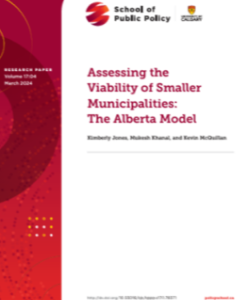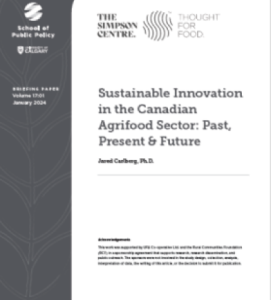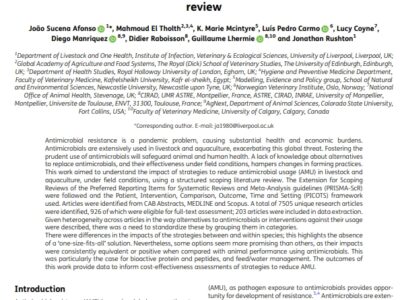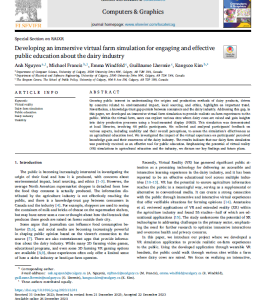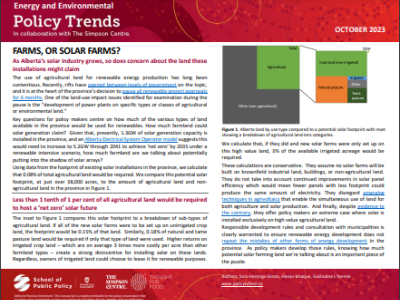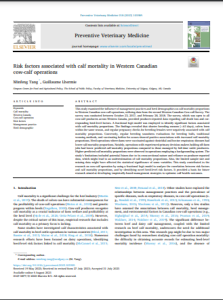Publications
Small towns, villages and rural areas in Alberta face serious fiscal challenges due to economic and social trends that have seen their populations stagnate or decline while job opportunities and young people leave for bigger cities. While other provinces have opted for sweeping reorganization to local governments, including amalgamation, annexation or the establishment of regional forms of government, Alberta has chosen a case-by-case approach to its municipalities through the use of viability reviews.
Alberta’s viability review process is an excellent way for the province to monitor and address the fiscal struggles of individual municipalities. More must now be done to fine-tune the postdissolution process so that Alberta Municipal Affairs can equitably address the governance problems that follow.
Friday, March 01, 2024
Kimberly Jones, Mukesh Khanal, and Kevin McQuillan
In order to remain globally competitive with sustainable innovations in agri-food, both the public and private sectors in Canada must increase investment in the industry.
Studies reveal that both sectors’ support for agri-food innovation has declined in recent years. To spur innovation and growth public funding should revert to previous levels, ideally reaching 0.10 per cent of GDP. Incentives such as tax relief, matching funds and enhanced protection of intellectual property rights could spur increased levels of private sector investment in innovation.
In the past 50 years, innovation in agriculture has brought tremendous benefits to producers, processors and consumers. Successful innovations include genetically modified crops, large-scale cattle feeding operations and the adoption of no-till farming, which has reduced the traditional practice of summerfallowing fields. Still, with the demand for a secure global food supply and growing concerns about the environmental impacts of large-scale farming, the need for sustainable innovation in the agri-food sector is pressing.
This paper offers three recommendations for policy-makers. First, public funding for agricultural research and development should be increased to prior levels. Next, the private sector needs more favourable conditions to foster investment in the agri-food industry. Last, if intellectual property rights are strengthened, innovating firms will be reassured that they can capture the economic benefits innovation creates.
Wednesday, January 31, 2024
Jared Carlberg
Antimicrobial resistance is a pandemic problem, causing substantial health and economic burdens. Antimicrobials are extensively used in livestock and aquaculture, exacerbating this global threat. Fostering the prudent use of antimicrobials will safeguard animal and human health. A lack of knowledge about alternatives to replace antimicrobials, and their effectiveness under field conditions, hampers changes in farming practices. This work aimed to understand the impact of strategies to reduce antimicrobial usage (AMU) in livestock and aquaculture, under field conditions, using a structured scoping literature review. The Extension for Scoping Reviews of the Preferred Reporting Items for Systematic Reviews and Meta Analysis guidelines (PRISMA-ScR) were followed and the Patient, Intervention, Comparison, Outcome, Time and Setting (PICOTS) framework used. Articles were identified from CAB Abstracts, MEDLINE and Scopus. A total of 7505 unique research articles were identified, 926 of which were eligible for full-text assessment; 203 articles were included in data extraction. Given heterogeneity across articles in the way alternatives to antimicrobials or interventions against their usage were described, there was a need to standardize these by grouping them in categories. There were differences in the impacts of the strategies between and within species; this highlights the absence of a ‘one-size-fits all’ solution. Nevertheless, some options seem more promising than others, as their impacts were consistently equivalent or positive when compared with animal performance using antimicrobials. This was particularly the case for bioactive protein and peptides, and feed/water management. The outcomes of this work provide data to inform cost-effectiveness assessments of strategies to reduce AMU.
Friday, November 10, 2023
João Sucena Afonso, Mahmoud El Tholth, Luis Pedro Carmo, Lucy Coyne, Diego Manriquez Alvarez, Didier Raboisson, Guillaume Lhermie, and Jonathan Rushton
Growing public interest in understanding the origins and production methods of dairy products, driven by concerns related to environmental impact, local sourcing, and ethics, highlights an important trend. Nevertheless, a knowledge-trust gap persists between consumers and the dairy industry. Addressing this gap, in this paper, we developed an immersive virtual farm simulation to provide realistic on-farm experiences to the public. Within the virtual farm, users can explore various sites where dairy cows are raised and gain insights into dairy production processes using a head-mounted display (HMD). This simulation was demonstrated at local libraries, involving 48 public participants. We collected and analyzed participants’ feedback on various aspects, including usability and their overall perceptions, to assess the simulation’s effectiveness as an agricultural education tool. We investigated the impact of the virtual experience on participants’ perceived knowledge gain and their awareness of the dairy industry. The results indicate that our dairy farm simulation was positively received as an effective tool for public education. Emphasizing the potential of virtual reality (VR) simulations in agricultural education and the industry, we discuss our key findings and future plans.
Tuesday, October 31, 2023
Anh Nguyen, Michael Francis, Emma Windfeld, Guillaume Lhermie and Kangsoo Kim
The use of agricultural land for renewable energy production has long been contentious. Recently, rifts have opened between levels of government on the topic, and it is at the heart of the province’s decision to pause all renewable project approvals for 6 months. One of the land-use impact issues identified for examination during the pause is the “development of power plants on specific types or classes of agricultural or environmental land.”
Key questions for policy makers centre on how much of the various types of land available in the province would be used for renewables. How much farmland could solar generation claim? Given that, presently, 1.3GW of solar generation capacity is installed in the province, and an Alberta Electrical System Operator model suggests this would need to increase to 5.2GW through 2041 to achieve ‘net zero’ by 2035 under a renewable intensive scenario, how much farmland are we talking about potentially putting into the shadow of solar arrays?
Tuesday, October 31, 2023
Sara Hastings-Simon, Hanan Ishaque and Guillaume L’hermie
Rangelands provide many ecosystem services such as food production, income for rural families and communities, recreation, wildlife habitat, soil carbon sequestration, plant and animal biodiversity, and water filtration. It is often assumed that grazing negatively impacts the natural ecosystem and that the removal of grazing would result in more pristine rangelands. Management-intensive grazing practices allow forages to store reserves during times of abundant precipitation, increase water-holding capacity, provide wildlife habitat at critical times of rearing young, and create a shifting mosaic with both old- and new-growth vegetation all the while maintaining animal productivity and income for ranchers. An analysis of the interaction between rangeland management practices and the ecosystem is needed.
The objective of this study was to determine the impact of combinations of management practices on the sustainability of rangelands in different ecoregions across the Great Plains. Six study sites were selected in Kansas, Nebraska, Wyoming, Montana, and South Dakota, encompassing the Flint Hills, High Plains, and Sandhills ecoregions. Twelve rangeland management scenarios were developed from combinations of stocking density (light, moderate, heavy), grazing management (continuous, rotational), and fire regime (no burn, spring burn) along with a no-management scenario. Each scenario was simulated at each site using established computer models: Agricultural Policy/Environmental eXtender model, Integrated Farm System Model, and Impact Analysis for Planning. Additionally, human-edible nutrient conversion was computed. A sustainability index was developed to encompass the three sustainability pillars (i.e., environmental, economic, and social) into a single value. Unmanaged rangelands generally had less soil (20%), nitrogen (30%), and phosphorus (50%) losses, although this was not consistent across ecoregions, and similar or greater soil carbon deposition than grazed rangelands. There was an interaction among stocking density, grazing management, fire regime, and ecoregion for many indicators of soil health, greenhouse gas emissions, economic activity, and human-edible nutrient conversion. The scenarios with the greatest overall sustainability index value had moderate to high index values for each of the three pillars (people, planet, profit). In conclusion, the ranking of rangeland management practices based on sustainability indicators was inconsistent across ecoregions, indicating that the optimal management system to improve sustainability of rangelands is not the same for all ecoregions.
Monday, October 30, 2023
Merri E. Day, Minfeng Tang, Phillip A. Lancaster, Deann Presley, Dustin L. Pendell, Walter H. Fick, Luca Doro, Adam Ahlers and Andrew Ricketts
